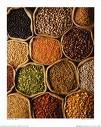So I haven’t answered all of the questions, I have about 40 more to go, but I want to answer them thoroughly so it will take a little longer. I want to dedicate this post to one question:
What are some ideas for gluten intolerance (rice and soy get boring fast)?
What a GREAT question. Personally, I am going to cook gluten-free for the next month for my family because I have a hunch that my 2 year old either has a wheat allergy or a gluten intolerance. Hopefully by the end of the month we’ll have a better idea of whether or not it’s the gluten and/or wheat.
We cook with a lot of whole grains in our house, so it shouldn’t be to big a transition but a little more work because I do make sandwiches and things like pizza crust, pancakes, ect. out of whole-wheat products and my kids do like oatmeal (which is wheat-free but not gluten free).
Here’s a list of grains that are either wheat free or gluten free:
Even if you can’t eat wheat, rye, barley, or oats, there are several other grains and legumes that are not only acceptable alternatives to wheat, but they’re loaded
with flavor and nutrients. Brown rice is whole-grain and wholesome. Some of the lesserknown
and often ancient grains and non-grains are great tasting, and particularly high in
protein, vitamins, and minerals. All of these can be made into flours.
with flavor and nutrients. Brown rice is whole-grain and wholesome. Some of the lesserknown
and often ancient grains and non-grains are great tasting, and particularly high in
protein, vitamins, and minerals. All of these can be made into flours.
Here are some of the many choices available to you on a wheat- or gluten-free
diet: (WF = wheat-free; GF = gluten-free)
diet: (WF = wheat-free; GF = gluten-free)
· Amaranth (WF/GF)
· Buckwheat/groats/kasha (WF/GF)
· Cassava (arrowroot) (WF/GF)
· Chickpea (garbanzo) (WF/GF)
· Buckwheat/groats/kasha (WF/GF)
· Cassava (arrowroot) (WF/GF)
· Chickpea (garbanzo) (WF/GF)
Corn (WF/GF)
Flaxseed (WF/GF)
· Job’s Tears (WF/GF)
· Millet (WF/GF)
· Montina (WF/GF)
· Oats (WF, but oats in the United States can be contaminated with wheat
and other grains)
· Quinoa (WF/GF)
· Ragi (WF/GF)
· Rice (WF/GF; only brown rice is whole grain)
· Sorghum (WF/GF)
· Soy (WF/GF)
· Tapioca (WF/GF)
· Taro root (WF/GF)
· Teff (WF/GF)
· Job’s Tears (WF/GF)
· Millet (WF/GF)
· Montina (WF/GF)
· Oats (WF, but oats in the United States can be contaminated with wheat
and other grains)
· Quinoa (WF/GF)
· Ragi (WF/GF)
· Rice (WF/GF; only brown rice is whole grain)
· Sorghum (WF/GF)
· Soy (WF/GF)
· Tapioca (WF/GF)
· Taro root (WF/GF)
· Teff (WF/GF)
Wild Rice (WF/GF) (this is technically a seed, not rice)
Tubers, such as potatoes in all of their varieties (baking, yukon gold, Idaho, red, fingerling) and sweet potatoes/yams are also great gluten-free starches. Legumes, of course, are also gluten-free.
I came across two great websites: http://www.glutenfreemommy.com/ and http://www.celiac.com/. Now that gluten-intolerance, wheat allergies, and celiac disease are better diagnosed, gluten-free cooking is so much easier than ever before because the resources are out there.
I’m starting the gluten-free challenge today and I’ll have to keep you posted on how it goes. For breakfast this morning I made short-grain brown rice and blended it in my Blend-tech until mostly creamy with still some consistency, added rice milk, cinnamon, a pinch of sweetner and topped with wild blueberries. My kids loved it.




Comments